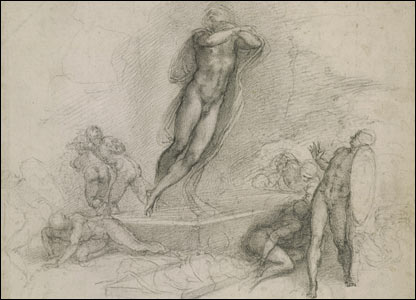Michelangelo’s early biographers called him “the divine Michelangelo”, insinuating that he was no ordinary mortal but a being sent from heaven. When he was still only in his twenties, he created the most famous sculpture in the world, the monumental figure of David, carved from a block of Carrara marble so enormous that it had defeated generations of Florentine sculptors before him. He went on to create the most celebrated cycle of paintings in the entire canon of Western art, the ceiling of the Sistine Chapel, together with the great Last Judgement on its far wall. As if that were not enough, he also designed the most moving and eloquent architectural masterpiece of the High Renaissance, in the shape of the Laurentian Library staircase – a chamber of blind windows, a dream of darkness awaiting enlightenment, articulated from dumb stone. He was also one of the subtlest poets of sixteenth-century religious experience, weaving strands of neo-Platonic idealism and post-Reformation Christian anxiety into sonnets of great power and feeling. His achievements are so multifarious, so awe-inspiring, that he himself can seem a forbiddingly remote genius: an admirable but unknowable giant of the Renaissance.
For a truly intimate sense of Michelangelo as a human being – for a sense of all the effort, and all the changes of mind, that lay behind his astonishing creations; for a sense of his sympathy, and of his kindness as a teacher of others; for a sense of his capacity for love; for a sense of his self-doubt, and of the penitential intensity of religious feeling to which he was frequently subject – for all this, it is necessary to turn to Michelangelo’s drawings. Michelangelo himself did not make this particularly easy to do. Late in life, he destroyed a large quantity of his drawings,...

Michelangelo’s Drawings at The British Museum
19-03-2006

